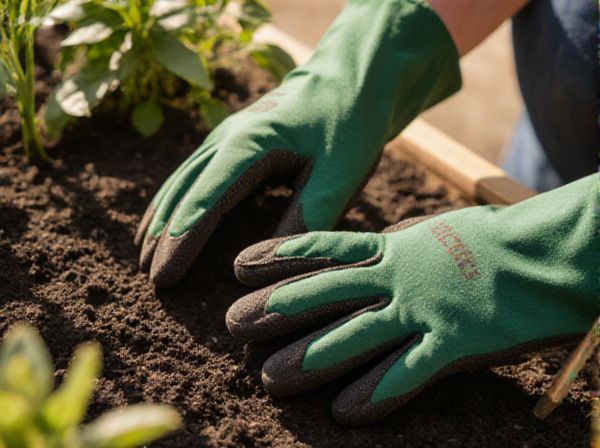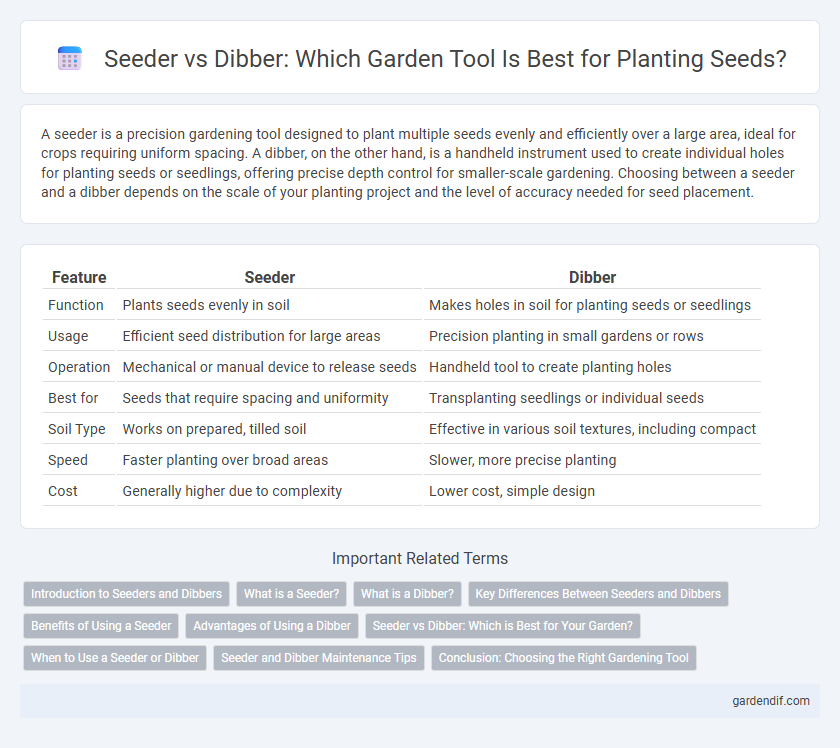
Seeder vs Dibber Illustration
A seeder is a precision gardening tool designed to plant multiple seeds evenly and efficiently over a large area, ideal for crops requiring uniform spacing. A dibber, on the other hand, is a handheld instrument used to create individual holes for planting seeds or seedlings, offering precise depth control for smaller-scale gardening. Choosing between a seeder and a dibber depends on the scale of your planting project and the level of accuracy needed for seed placement.
Table of Comparison
| Feature | Seeder | Dibber |
|---|---|---|
| Function | Plants seeds evenly in soil | Makes holes in soil for planting seeds or seedlings |
| Usage | Efficient seed distribution for large areas | Precision planting in small gardens or rows |
| Operation | Mechanical or manual device to release seeds | Handheld tool to create planting holes |
| Best for | Seeds that require spacing and uniformity | Transplanting seedlings or individual seeds |
| Soil Type | Works on prepared, tilled soil | Effective in various soil textures, including compact |
| Speed | Faster planting over broad areas | Slower, more precise planting |
| Cost | Generally higher due to complexity | Lower cost, simple design |
Introduction to Seeders and Dibbers
Seeders are agricultural tools designed to plant seeds uniformly at precise depths and spacing, enhancing crop yield and planting efficiency. Dibbers, also known as dibblers, create holes in the soil manually to place seeds or seedlings, suitable for small-scale gardening tasks. While seeders automate the sowing process, dibbers provide control and versatility for delicate or varied planting arrangements.
What is a Seeder?
A seeder is a gardening tool designed to plant seeds efficiently by creating uniform rows and spacing, ensuring optimal soil contact for better germination rates. It automates seed distribution, reducing manual labor and improving planting speed compared to traditional methods like dibbing. Seeders come in various types, including hand-push, mechanical, and pneumatic models, each tailored to different scales of cultivation and seed sizes.
What is a Dibber?
A dibber is a gardening tool designed for making precise holes in the soil to plant seeds, bulbs, or seedlings efficiently. It typically features a pointed wooden, metal, or plastic shaft that helps in creating consistent planting depths. Unlike seeders, which automate seed distribution, a dibber offers manual control over planting locations and depths, ensuring optimal growth conditions for individual plants.
Key Differences Between Seeders and Dibbers
Seeders automate the planting process by evenly distributing seeds at precise depths and spacing, suitable for large-scale farming. Dibbers are manual tools designed to create holes in soil for individual seed placement, allowing for controlled germination in small gardens or nurseries. The key differences lie in their scale of use, efficiency, and precision, with seeders enhancing speed and uniformity, while dibbers offer hands-on control over planting locations.
Benefits of Using a Seeder
Using a seeder significantly improves planting efficiency by allowing precise seed placement at uniform depths, which enhances germination rates and crop yields. Seeders reduce labor time and effort compared to manually creating holes with a dibber, making them ideal for larger-scale farming operations. The consistent seed spacing provided by seeders also minimizes seed wastage and promotes healthier plant growth.
Advantages of Using a Dibber
Using a dibber offers precise hole-making for planting seeds or bulbs, ensuring consistent depth and spacing. Its ergonomic design reduces hand fatigue during repetitive tasks, improving efficiency in garden planting. Unlike seeders, dibbers require less maintenance and are ideal for small-scale or detailed planting work.
Seeder vs Dibber: Which is Best for Your Garden?
Seeders distribute seeds evenly across soil, making them ideal for planting large areas quickly and ensuring consistent germination rates. Dibbers create precise holes for individual seeds or seedlings, offering better control for delicate or spaced planting. Choosing between a seeder and dibber depends on garden size and planting precision needs.
When to Use a Seeder or Dibber
Use a seeder for planting large areas quickly with uniform seed distribution, especially in vegetable gardens or lawn establishment. Choose a dibber for precise planting of seeds or seedlings in small-scale gardening tasks requiring accuracy, such as in raised beds or container gardens. Selecting between a seeder and a dibber depends on the scale and precision needed for planting operations.
Seeder and Dibber Maintenance Tips
Regular maintenance of seeders and dibbers includes cleaning the tools thoroughly after each use to prevent soil buildup and rust formation. Lubricating moving parts of seeders and checking dibber tips for wear ensure efficient planting and prolong tool lifespan. Storing these tools in a dry location minimizes corrosion and keeps them in optimal working condition.
Conclusion: Choosing the Right Gardening Tool
Selecting the right gardening tool depends on the specific task and soil conditions; seeders excel in precise seed placement for larger gardens, while dibbers offer simplicity and versatility for planting individual seeds or bulbs in smaller plots. Gardeners prioritizing efficiency and uniformity benefit from seeders, whereas those seeking control and adaptability prefer dibbers. Understanding the distinct advantages of each tool ensures optimal planting results and healthier plant growth.
Seeder vs Dibber Infographic

 gardendif.com
gardendif.com